A temple is a history, A temple lost is a history lost; A temple kept is a history kept but atemple preserved is a history preserved and architecture is a visual art, and the buildings speak for themselves.
The following study focuses on Kashiraj Kali Temple built by Kashiraj and its significance among local people through their rituals and traditions. The aim of this study is to promote the idea for working towards preservation of these temples so that it can sustain over the years.
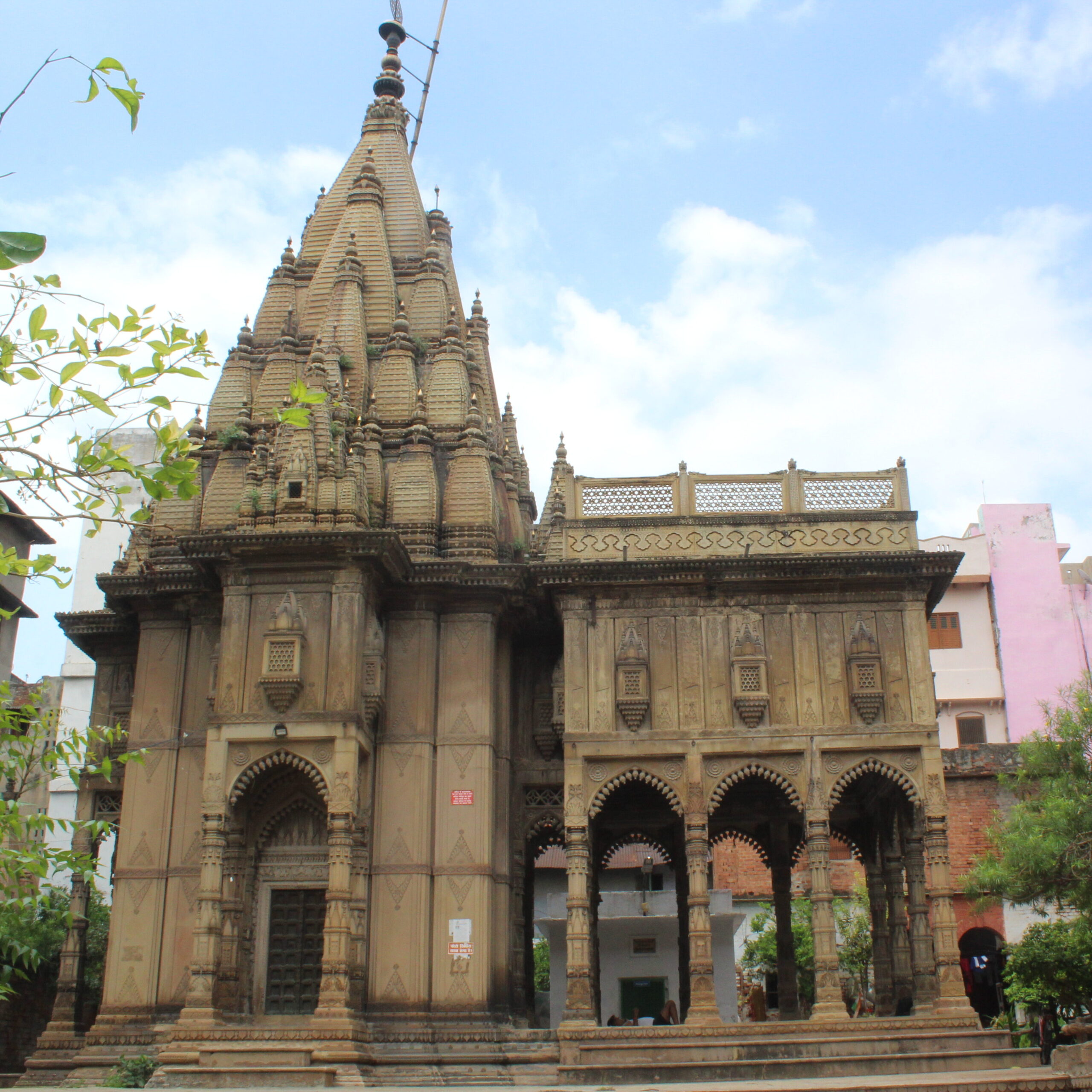
BANARAS: AN INTRODUCTION
‘By seeing Banaras, one can see as much of life as the whole India can show’ : (Singh. Rana. P.B, 1997)
Varanasi or Banaras (also known as The City of Light), is one of the oldest living cities in theWorld, situated South-Eastern portion of Uttar Pradesh in Northern India. This magnificent city developed from the western bank of River Ganga, where river Ganga great Cresent shape toward North. The official name of Varanasi is not a modern name. It is possibly based on the fact that it lies between where the Varuna River, to the north, and the river Assi, to the south, flow into the river Ganga. The name Varanasi was spelled Baranasi in Pali, which ultimatelygave birth to the name Banaras.
Varanasi, the oldest inhabited city of the world, originally known as the Kashi (Kashi word was derived from the ‘Kasha’ which means the brightness). Varanasi is renowned by many names, some of are Brahma Vardha, Anandakanana, Avimuktaka, Mahasmasana, Kasi, Sudarsana, Surandhana and Ramya. Currently Kashi is known by the name Varanasi which was derived from the two tributaries of the holy River Gange named Varuna and Assi.Kashi is situated at the banks of the Holy River Ganges in the Uttar Pradesh state of India.
It is the oldest living city and is heterogeneous with multiple layers of religion, culture, artforms, believes nature, profiles, and individuality. Its history goes back to several millennia. ‘Mark Twain (1898, p. 480), the famous English literateur once wrote: “Banaras is older than history, older than tradition, older even than legend and looks twice as old as all of them put together.” ‘Banaras is not the story of bricks and stones; it is, in fact, living history in itself ‘(Singh and Rana 2006, p. 21). Lewis Mumford, in his book ‘ The City In history’, wrote thata city is an “Energy Converter Into Culture’(eck. L. Diana,1993).
It is located in the North India in the middle valley of Gange, in the east part of the UP stateand around 320 kilometres southeast to the Lucknow.
Kashiraj Kali Mandir
Kashiraj Kali Mandir, is a popular Hindu temple located in Godowlia , the heart Varanasi, India. This temple is dedicated to Goddess Kali, who is considered as one of the most powerful and revered goddesses in the Hindu religion. The temple is situated on the banks of the river Ganges and attracts thousands of devotees every year.
According to the inscriptions ,inscribed in Hindi and Sanskrit , this temple was built by the mother of the then King Prabhu Narayan Singh in Samvat 1843 ,Falfun Sadi 5 ,on Sunday. The temple was built to honor the goddess Kali .The temple has undergone several renovations over the years, but it still retains its ancient charm and grandeur.
ARCHITECTURE :
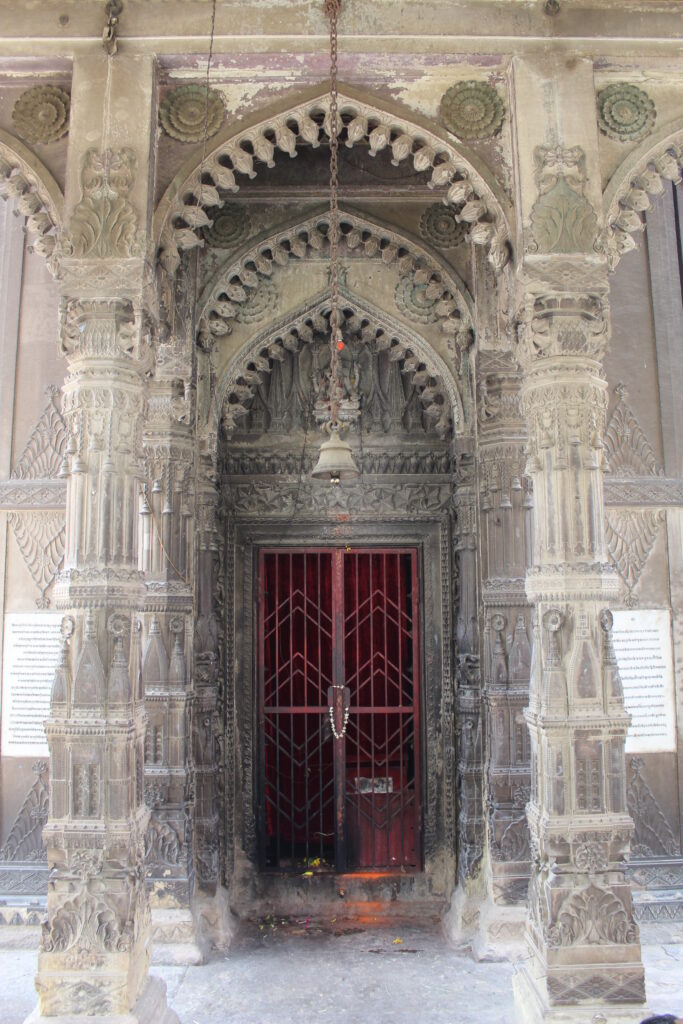
This temple is built of raised platform called Jagati. Seven stairs leads to jagati and then three stairs leads to Temple.
Kashiraj Kali Mandir’s architecture is a fusion of traditional and contemporary designs. The temple is constructed in the conventional Hindu architectural style, and the walls and ceilings are decorated with elaborate carvings and sculptures. The temple’s primary goddess, Goddess Kali, is shown in a stunning and mesmerising idol that is encrusted with priceless diamonds and jewellery.
In this temple God Shiva is also worshipped in the form of Shivlinga along with a Nandi. Additionally, the temple is home to a number of minor shrines honoring additional Hindu deities.
This temple is divided in three parts ,i.e, Mukhmandapa,Antarala and Garbhagriha . It is best know for its intricate and detailed carving .
There is a huge intricately carved Torana dwara or gateway leading to temple present there. Right now ,advertisement board and sign boards can be seen on the gate ,inside this some shops and restaurants are there.
MUKHMANDAPA :
This is the main entrance of the temple. It is a large hall with series of intricately carved pillars on it . There are four pillars in first series ,then two pillars in second series ,then again two pillars in third series , then again four pillars in fourth series . Overall , 12 pillars are there in Mukhmandapa . Mukhmandapa is opened in all four sides , 3 pointed arches are present on all four sides of Mukhmandapa. Chajja is there on roof of Mandapa. The pillars are adorned with intricate carvings of Temple like motifs,series of bell and chains , pot shaped motifs along with floral and petaled motifs. Parrot shaped motifs are also there on Pillars . A lotus petaled floral motif is there on centre of Mukhmandapa.
ANTARALA :
There is a small passage joining Mukhmandapa to Gabhagriha ,typically found in temples called as Antarala or Vestibule. Two pointed arches are present on antarala ,one on left side and another on right side . Two intricately carved Pilasters with motifs like series of bell and chains , pot shaped motifs along with floral and petaled motifs . Parrot shaped motifs are also there on Pilasters . The ceiling of antarala is rectangular in shape with floral motifs in centre along with rectangular border. Two inscriptions are inscribed on wall of Antarala, one in Sanskrit and one in Hindi which tells us about the patron of the temple .
The inscription states that,
“श्री श्रीमान्काशिराजशिजराज महाराज ईश्वरी प्रसाद नारायण सिंह बहादुर कशनष्ठम्रातानर नारायण शसिंह बेशतया राज्य केस्वनामधन्य श्रीमान्महाराज नवलशकिोरशसिंहशजन के प्रथम पुत्र अलौशकक दानवीर श्री महाराजराजेंद्रशकिोरशसिंह शितीय महाराज कु मारमहेंद्रशकिोरशसिंह और कशनष्ठाकन्या जोशक महाराजकुमार श्रीनर नारायण शसिंह की धर्म्मपत्नी और सवमगुण सिंपन्न प्रतापिाली धर्म्मप्राण श्रीमान्महाराजाशधराज प्रभुनारायणशसिंह बहादुरजोइस समय कािी शसिंहासन पर शवराजमान हैउनकी पूजनीया माता थी उन्ही के करकमलो सेइस मिंशदर मेंसिं.१८४३ फाल्गुण सुदी ५ रशववार की पञ्चदेव का स्थापन भया ।।”
PILLARS :
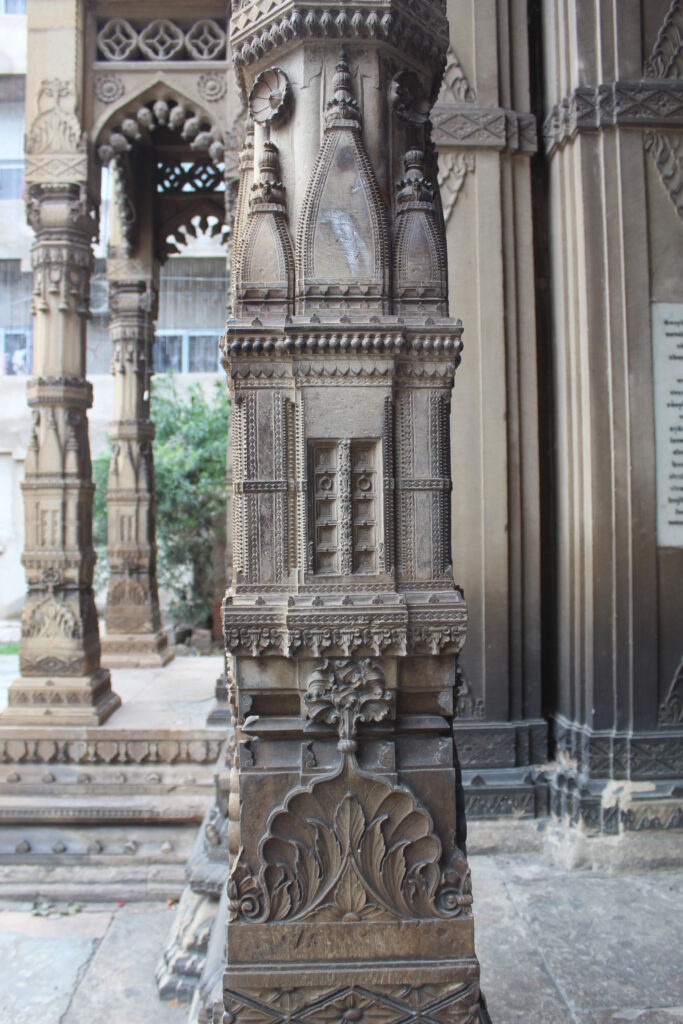
The Pillars are intricately and detailed carved with several series of motifs like series of bell and chains , pot shaped motifs along with floral and petaled motifs .Parrot shaped motifs are also there on Pillars.
In lower part of pillars ,floral and leaf motifs are present ,then Temple shaped motifs along with doorway with 8 blocks and shikara over it are present.Above this floral motifs are carved ,then some geometric motifs are carved ,then some creepers shaped motifs are carved ,above this series of chains and bells are carved ,above it pot is there ,then again some creepers and floral motifs are carved .In the topmost part of pillars two Parrots are carved with floral motif in centre ,it seems that Parrots are eating these flowers.
GARBHAGRIHA :
The black coloured idol of Goddess Kali ,a form of Shakti/Durga is intalled in centre of Garbhagriha. The frame of idol is highly carved and brightly coloured . Apart from this Shivlinga is also installed inside the garbhagriha . God Ganesha is installed on Lalatbimba. There are three doorways to Garbhagriha but only right side one is use to open. The doorways are wooden with squarish blocks are present on it. Seated Nandi ,the vehichle of God Shiva is present on outside of right gateway to Garbhagriha.
Two pillars and two pilasters are present on either side and back side of Garbhagriha.There are series of 3 arches present on all three sides of Garbhagriha.Two Gomukhas are present on either side of Garbhagriha through which the milk,water offered during rituals is carried out from the Garbhagriha . On all three doorways series of floral motifs and creepers friezes are carved . On the back side of Garbhagriha ,outer wall is carved like doorways ,one broken Kirtimukha is present on lower part of Pilaster present on left side .It seems that one Kirtimukha of righter side is broken .
SHIKHARAS :
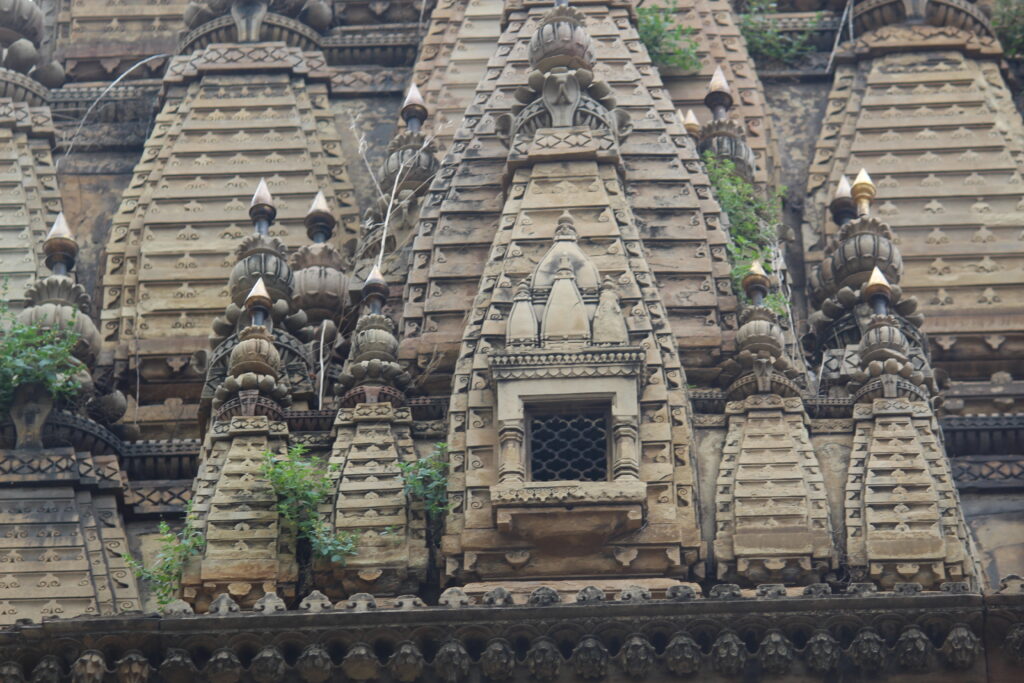
Prominent shikara of Nagara style is found. There are series of miniature shikhara or urushringa are present above the Garbhagriha of the temple.Amlaka ,Kalasha,Chandrika,,etc. along with a metalled flag is present over the shikhara .
FESTIVALS AND RITUALS :
The temple is renowned for its potent spiritual energy, and devotees who come there with a pure heart and mind are said to have their desires granted. The goddess Kali, who is revered for her capacity to vanquish evil spirits and negativity, is also connected to the temple. She is regarded as a furious and strong divinity. At Kashiraj Kali Mandir, many festivals are enthusiastically observed. Navratri, a nine-day celebration devoted to the worship of the goddess Durga, is the most important holiday observed at the temple. The temple is decorated for Navratri with lights and ornaments, and thousands.
CONCLUSION
Hence ,on the basis of above mentioned. I can conclude that the study focuses on the templearchitecture of Kashiraj of Varanasi. The study focuses built by Kashiraj and its significance among local people through their rituals and traditions.The aim of this dissertation is to promote the idea for working towards preservation of these temples so that it can sustain over the years as , A temple is a history: A temple lost is a history lost; A temple kept is a history kept but a temple preserved is a history preserved and architecture is a visual art, and the buildings speak for themselves.
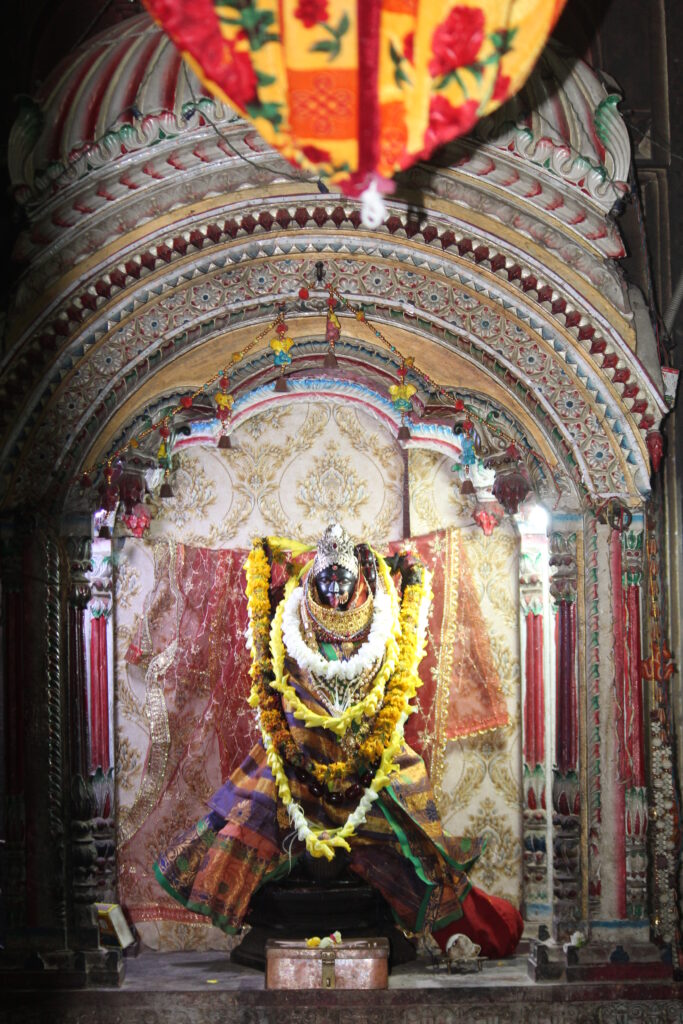

Abhay Pratap Singh holds a Master’s degree in History of Art from Banaras Hindu University. With a profound passion for photography, architecture, and the rich tapestry of history, art, and culture. Abhay combines his academic knowledge with his creative pursuits. Beyond his professional interests, he is deeply committed to social causes, actively working with Drishti: The helping hands , an NGO dedicated to supporting visually impaired students .
